
In the previous incarnations of this series examining what Star Wars could stand to take a few lessons from, Mike Cooper examined the Avatar franchise (no, not that one) and Lucas Jackson took a long look at the exquisitely-executed pseudohistorical freerunning-with-a-side-of-murder simulators that comprise Assassin’s Creed. In today’s article, we’ll be probing another series of popular video games: BioWare’s Mass Effect, unhelpfully defined by Wikipedia as “a series of science fiction action role-playing third person shooter video games.”
For those whose knowledge of the franchise begins and ends with that vague, kitchen sink-esque description, we’ll take a few moments to elaborate on the nature of the games and the overarching story before we move on to the meat of the article. In Mass Effect, players take on the role of Commander [insert name here] Shepard, a highly-trained marine in the military of the Systems Alliance (the interstellar arm of humanity) in the year 2183, serving aboard the SSV Normandy, a state-of-the-art prototype stealth reconnaissance frigate.

Thirty-five years prior to the start of the games, human prospectors discovered ancient alien ruins buried beneath the surface of Mars. These ruins belonged to an extinct species of aliens (called Protheans) that vanished from the face of the galaxy suddenly and without explanation fifty thousand years earlier, and would later lead humanity to uncover a type of Prothean superstructure called a mass relay enclosed within Charon, one of Pluto’s moons, which served as a method of instantaneously transporting starships between corresponding devices in different solar systems.
By the start of the first game, humanity has come to join an international community comprised of multiple sentient alien species and governed by the Citadel Council, a sort of interstellar United Nations headquartered aboard an ancient space station called the Citadel, another relic of the Prothean age. What begins as a routine shakedown run for the SSV Normandy soon escalates far beyond what anyone could have predicted, however, when its crew becomes embroiled in a plot to resurrect a primordial menace capable of extinguishing all life in the galaxy.
Lesson #1: Aliens are people too
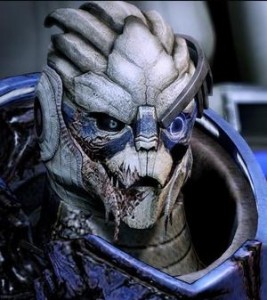
Unusually for a work of science fiction, many (if not most) of Mass Effect‘s non-human characters are vastly more popular among its players than its human cast – including its ostensible protagonist. Unlike Chewbacca or Jar Jar Binks, Mass Effect‘s aliens are not mere sidekicks or token comic relief. Each and every one of them is a fully developed and well-rounded character, with recurring missions based around their lives that are often almost or completely unrelated to the game’s main story, as well as extensive backstories that are impressive even by the standards of a franchise that prides itself on providing a life story for characters as obscure as that one guy in the background of The Empire Strikes Back on Bespin running down a hallway carrying an ice cream maker.
Despite their alien appearances, what they are is often secondary to who they are (though that is not to say their alien nature is ever ignored – far from it). Garrus Vakarian may be a turian (a militaristic species bearing a vague resemblance to anthropomorphic avians), but he is also a police officer, a skilled sniper, and so popular among the fans that he was upgraded to the status of a romanceable option for female Shepards in the second game.
It must also be noted that characters like Garrus do not constitute a exception to the rule when it comes to the treatment of alien species in Mass Effect universe, where humans are far from possessing a monopoly on significance to the plot. At the start of the story, three species hold seats on the Citadel Council – the turians, the asari, and the salarians. Humans, notably, are not among them, which is a point of some contention between the Systems Alliance and the rest of the galactic community, due to their strong desire for a seat at the table despite their relatively recent arrival, compared to other species that are far ahead of them in the waiting line.

When the time comes to gather allies to avert catastrophe, much of the focus is on earning the trust and aid of various alien species and their representatives, without whom success would be all but impossible. The need to bridge the gap between species, no matter how incomprehensible or foreign they may seem, and the spirit of cooperation are prominent and significant recurring themes throughout the trilogy – on several occasions, the crew of the SSV Normandy is able to forge alliances with entities that no one else would have even dreamed of even trying to communicate with.
Compared to the usual treatment of aliens in Star Wars, the differences are striking. Mass Effect presents us with aliens as alive and fleshed out as any human being and beloved by the audience, while Star Wars’ aliens often barely scrape by as supporting characters and antagonists. If there is an assumption that audiences will be unable to sympathize with a prominent alien character, then Mass Effect reveals that to be obviously false. Its aliens star in their own comics, and further games in the franchise have been contemplated centered entirely around them, absent the human Commander Shepard.
Imagine that for a moment, a game where one assumes the role of an alien, not by player design, but because a preexisting non-human character is considered sufficiently popular to warrant their own spinoff. Mass Effect teaches us that if you make a genuine effort to portray your aliens as people, if not necessarily humans, then your audience will accept them as readily as they would any human character. Given the reception of the addition of Ewoks and Gungans to the Star Wars universe, any portrayal of an alien species as successful as Mass Effect‘s is one worthy of serious examination and emulation.
Lesson #2: Share the spotlight
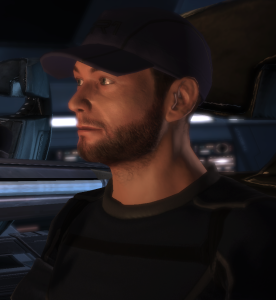
If one were to judge a game by its cover alone, one could be forgiven for mistaking Mass Effect for yet another dull, mundane shooter starring yet another dull, generic white male human soldier shooting yet more dull, funny-looking alien species in the face. Thankfully, such an assumption would be the furthest thing from the truth: it’s an exceptional, exciting role-playing shooter starring a race- and gender-variable human soldier shooting many different kinds of humans and aliens in the face. But I digress. Commander Shepard may be the focus of the game’s action, but the weight of the story is distributed across many more shoulders of all shapes and sizes than one would expect.
The first entry in the series provides a roster of six quite diverse party members to choose from when selecting allies to accompany you into the field on your missions – two human, four alien, three male, three female. The second game dramatically increases this number to a total of thirteen possible party members – eight alien, five human, six male, six female, one not applicable. Significantly, these calculations do not take into account the significant number of supporting characters you encounter over the course of the games who do not directly follow you into battle.
The overall story is one told on a galactic scale, but Mass Effect always makes sure that it is not one told at the expense of individual tales. That these characters support you is never taken for granted, most requiring the completion of a mission centered around their recruitment to your cause before you’re able to count them as a member of your team. Once so aligned with your interests, their parts are far from done, and further missions will eventually arise that have far more to do with their own lives than Commander Shepard’s, and the second game requires the completion of these quests to their satisfaction in order to truly cement their loyalty to you on a personal basis.
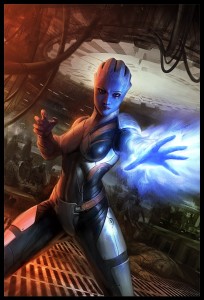
Members of your team are always available for you to converse with regarding recent events or completed missions, and will be more than happy to offer their own opinions, provide insight into their own histories, or even engage in debates with you. As occurs in other BioWare games, each character also has a set of dialogue assigned to occur at certain times and places when taken into the field, so that the player is never left with the feeling that their team is following them blindly and mutely.
In a franchise that is still struggling to move on from the same trio of protagonists that it began with thirty-five years ago, Mass Effect‘s example is invaluable. It successfully accomplished what every series desires, but so few achieve – having a compelling protagonist and a vast and interesting supporting cast more than capable of carrying on their own stories in the absence of the hero. Telling is the fact that the first novel published in Mass Effect‘s expanded universe, authored by our own Drew Karpyshyn, was a prequel featuring Commander Shepard’s commanding officer aboard the SSV Normandy, Captain David Anderson.
Mass Effect teaches us that we can fill many different baskets with heroic eggs while still telling a fascinating story, and that it’s possible to develop interesting secondary characters into prominent heroes in their own right, without taking away from the accomplishments of the protagonists or losing the audience’s interest. Given the opportunity to shine, Wedge Antilles can win over the audience just as successfully as Luke Skywalker or Han Solo, and when the saga has drawn to a close, is perfectly able to carry his own story into the future.
Lesson #3: Morality is not a thermometer

Like most other role-playing games produced by BioWare, Mass Effect institutes a system designed to keep track of the protagonist’s morality, as determined by their actions. In Knights of the Old Republic and The Old Republic, this takes the form of a meter measuring the player’s immersion in the light or dark sides of the Force. Evil actions move the player further down the scale and deeper into the dark side, while good actions aid you in ascending to becoming a paragon of light-sided virtue. Accumulate equal numbers of light side and dark side “points,” and you will remain a neutral figure, existing in a sort of precarious balance between the two extremes.
While appropriate for the franchise’s mythology, such a binary system is often hindered by its inability to recognize nuance – decisions are framed in absolutes, the options presented to you either selfless acts of messianic virtue or diabolically cruel acts more befitting cartoonishly evil Saturday morning cartoon villains. This is restrictive not only to the player who desires to give depth to their character, but also the writers who are forced to construct scenarios with the restriction that outcomes fall only under absolute good or evil.
Mass Effect, on the other hand, takes a somewhat more subtle approach, instead choosing to frame the player’s approach to their mission in terms of being a “Paragon” or “Renegade.” Paragon decisions are idealistic and optimistic by nature, frequently involving the player voluntarily hindering their own progress and making their mission more difficult for the benefit of others. Renegade actions lean heavily toward the pragmatic and cynical, cutting corners where they deem it necessary and preferring a high probability of a less than ideal outcome to a small chance at a perfect one.
A Paragon seeks to turn enemies into friends, while a Renegade settles for neutralizing their enemies as efficiently and thoroughly as possible. Unlike BioWare’s Star Wars games, the first two Mass Effect games do not measure these two opposing philosophies on the same scale – the accumulation of Paragon points does not reduce your number of Renegade points, and vice versa. A predominantly Paragon player may still strike fear into the hearts of their enemies if they have a reputation for ruthlessness, even if their chosen path is ultimately a more noble one.
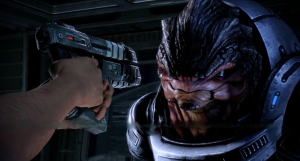
Such an approach permits a much greater degree of freedom than a set of binary light and dark side choices, encouraging players to think about their decisions in terms of how appropriate it is to the situation and their personal philosophy, rather than simply selecting the choice that corresponds with their cosmic moral alignment of choice. Our decisions should be what shape us into Jedi or Sith or something in between, and not be made for us according to which faction we identify with or what color our lightsaber is. Even if one thinks of it in terms of being Jedi or Sith and what suits the Star Wars mythology best, Mass Effect‘s system still seems like the better option of the two.
Falling to the dark side can be presented as a much more compelling and insidious cautionary tale when it’s the culmination of a long series of hard choices that seemed like good ideas at the time, rather than the product of a recently-acquired preference for yellow eyes, dark clothing, and the ability to shoot lightning from your fingertips. All aspects of the franchise could stand to benefit from such a change in perspective, given the frequency with which Jedi turn into the Sith and the unenthusiastic reception their falls often receive, Anakin Skywalker himself a prominent example.
Lesson #4: Diversify your portfolio of evil
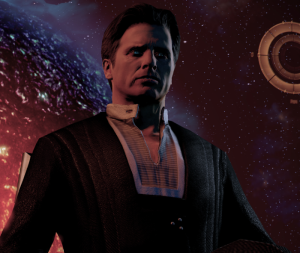
Fundamentally, the story of Mass Effect is centered around a conflict between our galaxy and an ancient alien menace bent on the annihilation of all life contained within it. In order to maintain the sinister sense of mystery about this menace, the series draws deeply from a vast and varied set of secondary and tertiary antagonists to provide a more direct and physical menace to its heroes. In their quest to avert calamity, Mass Effect‘s protagonists find themselves battling robotic hive minds, private military companies, alien terrorists, human supremacists, renegade artificial intelligences, telekinetic cultists, shadowy information brokers, common pirates, and many, many others.
The games wisely recognize that any one enemy, no matter how compelling or charismatic, faced with sufficient frequency, will eventually lose its ability to seize the audience’s attention and pose a believable and effective threat. A careful balance is struck so that an abundance of missions are always available for the player to face more mundane threats in addition to their struggle against the entities dwelling out in the great cosmic unknown.
If one compares this approach to Star Wars, the differences make themselves immediately and glaringly obvious. More than thirty-five out-of-universe years after the release of A New Hope, our primary antagonists still belong to the Empire or the Sith, and sometimes both. Legacy, taking place more than a century after the end of the Original Trilogy, features a resurgent order of Sith in command of a resurgent Empire as a threat. The massively multiplayer online role-playing game The Old Republic, taking place more than three and a half thousand years before the saga, features a Sith Empire that draws heavily on imagery from the films.
No matter where one looks, one is likely to find the Empire or the Sith more often than not. Even the largest and most notable attempt to introduce a new set of antagonists to date, the Yuuzhan Vong (a dogmatic species of extragalactic alien conquerors obsessed with self-mutilation and bent on the complete and utter annihilation of all “infidels” who do not use their particular brand of coral-based biotechnology), is said to have originated with the concept of a species of invading Force users (occasionally rumored to be, once more, the Sith themselves).

Mass Effect‘s driving conflict may revolve around the fate of the galaxy itself, but it never allows itself to forget that there’s more going on in the setting than just your primary mission. Facing down one great menace does not mean that all other threats in the galaxy simply lie down in silence, and they can be just as compelling antagonists as any other foe. The crew of the SSV Normandy regularly takes on threats of a scale that make the Yuuzhan Vong look mild by comparison, but that never takes anything away from the importance of their work in investigating mysterious disappearances, fracturing criminal organizations, and averting asteroid impacts.
The Sith and the Empire may be the primary antagonists of the Star Wars saga, but Mass Effect teaches us that you can take the time to look away from your most iconic enemy and still be just as able to tell fascinating and powerful stories of less extraordinary struggles. In our efforts to emulate the epic feel and scope of the Original Trilogy, we’ve often allowed ourselves to forget that five or ten lives being in peril is not inherently less worthy of our attention than a million or a billion. The fate of the galaxy may not hang in the balance, but we should never let that take away from what is on the line and worth fighting for.

Its good to hear someone else recognized that Star Wars needs to have more original ideas for antagonists. I never bother with later books anymore because it’s like “I’ve already seen this movie,”
Imagine what it feels like to those of us who read all those books. :p
There were more antagonists back in the early days of the 90s. It’s just that other than Thrawn, most of them were stupid. And I don’t mean that in terms of “I did not like this character” but rather the villains were lacking in basic logic and reasoning skills one needs to be a long term threat.